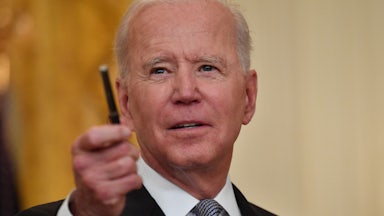Ohioans will vote on two ballot initiatives this November, centered on critical issues that could inspire either passionate or awkward debate at the Thanksgiving table a few weeks later: One is an amendment to enshrine the right to an abortion in the state constitution, and the other a proposal to legalize the purchase and possession of marijuana. Despite the lower turnout inherent in a year without a presidential or even midterm contest, the salience of these issues will likely raise the profile of an otherwise sleepy Election Day—and the success or failure of these initiatives will not fall neatly along party lines.
“The fact that these are issue elections, and there is no party officially tied to each of the ballot measures, that probably helps both of those issues,” said Robert Alexander, the founding director of the Institute for Civics and Public Policy at Ohio Northern University. “It’s really difficult in this highly polarized age to get Democrats and Republicans to agree on very much. Taking away party labels will likely lead to some agreement on these issues.”
It’s still unclear whether high turnout for one issue will encourage voter engagement on the other, but there are similarities between the two proposals that could encourage turnout for both. “Ultimately, the common theme is, voters want the freedom to make decisions about their own lives,” said Sarah Walker, the policy and legal advocacy director at the Ballot Initiative Strategy Center, which supports progressive ballot measures across the country.
Abortion rights and marijuana legalization are considered particularly important to younger voters, who are an increasingly critical demographic. The 2022 elections saw near-record turnout among young Americans, helping Democratic candidates to stave off a “red wave” in the congressional midterms. Even as younger voters generally lean Democratic, the presence of these initiatives on the ballot in November could motivate young voters of both parties to visit their polling sites. According to a 2022 poll by Pew Research Center, 47 percent of Republicans under 30 believe abortion should be legal in all or most cases. Recent polling by Gallup also found that 65 percent of conservatives aged 18 through 29 supported legalization of marijuana use, as did 59 percent of conservatives aged 30 through 49.
But Mark Caleb Smith, a political science professor at Cedarville University, noted that younger voters tended to turn out more for candidate-based elections than ones solely dominated by issues. And while Ohio has multiple college campuses that could become “pockets of mobilization,” Smith says that will not necessarily translate to overwhelming youth turnout.
“If there are issues that are going to motivate young voters, I think these are the issues that would do that,” Smith said. “I think especially for young women, [with] the abortion question, they’ll be uniquely motivated perhaps in a way they would not be otherwise. But I would be surprised if we see an avalanche of the youth vote in November.”
Naturally, the success or failure of the initiatives will hinge on the effectiveness of the campaigns in favor and opposed—and politicians hope that success might pay dividends in later elections, depending on whether these campaigns add to the voter rolls. Ballot initiatives provide a unique opportunity to engage and register new voters, said Walker. “With the marijuana issue, we know looking at past places where ballot initiatives have been successful that it does engage a lot of young voters, and so that creates the opportunity for registering new voters and increased turnout,” she said.
Whether or not younger Ohioans come out in force in November, all indications suggest that these ballot initiatives have sparked a keen interest among Buckeye State voters in general. Earlier this month, Ohioans overwhelmingly rejected a ballot measure known as Issue 1, which would have raised the threshold for adding an amendment to the state constitution from a simple majority to 60 percent of the vote. Abortion rights supporters argued that this initiative was intended to prevent the passage of the constitutional amendment on abortion. The special election drew unexpectedly high turnout.
Despite its backing from major Republican officials in the state, the proposal significantly underperformed former President Donald Trump’s win in Ohio in 2020. It not only failed in urban counties but in multiple suburban and rural counties as well, which typically trend more Republican. (The marijuana ballot initiative would not have been affected by Issue 1, as it is not a proposed constitutional amendment.) It also received some notable opposition from prominent GOP politicians, like former Governor John Kasich.
But the outcome of the vote on Issue 1 is not a clear indication that the amendment will succeed. Many Republicans opposed the measure because they viewed it as overreach by a General Assembly attempting to dilute the direct democratic power of voters. “There’s a segment of that ‘no’ vote that was a principled ‘no’ vote against the process, that wasn’t really looking at the potential substance of what might happen in November,” Smith said. “I think you’re going to see some Republicans vote ‘no’ in November who voted ‘no’ also in August.”
Moreover, abortion is a powerful motivator for conservative voters who seek stronger restrictions. Voters are also not a monolith: A Republican voter who supports legalizing recreational marijuana for economic purposes—the initiative would establish a 10 percent sales tax on its purchase—could also oppose abortion for religious or ideological reasons.
Indeed, disagreements over the ballot language itself highlight the ideological tensions underpinning the question, and the visceral ways in which Ohioans could respond to the amendment itself. The summary text of the abortion amendment finalized by the Ohio Ballot Board this week changed language from mentions of a “fetus”—the medical term—to an “unborn child,” a move strongly opposed by the Democratic members of the board. Ohioans United for Reproductive Rights have filed a lawsuit with the state Supreme Court seeking to force the board to change the language back; a spokesperson referred to the alterations as “propaganda that is written by anti-abortion politicians.” Should the language relating to an “unborn child” remain, it could potentially influence how voters react to the amendment while at the ballot box.
Abortion has played a pivotal role in electoral politics in the wake of the U.S. Supreme Court decision overturning Roe v. Wade last June. In 2022, abortion rights measures succeeded everywhere they appeared on the ballot, including in red states such as Kansas, Kentucky, and Montana. This year, a special election for the Wisconsin Supreme Court hinged largely on abortion rights; the salience of the issue is generally seen as contributing to the victory of liberal Janet Protasiewicz in that contest.
However, the success of abortion-related measures in other states does not spell victory for the amendment on the ballot in Ohio in November, particularly given the outside attention and money the initiative is attracting. Although a July Suffolk University/USA Today poll found that nearly 58 percent of Ohio voters would support enshrining abortion rights in the state constitution, 57 percent of Republicans surveyed opposed the measure.
Meanwhile, ballot measures related to marijuana access have recently seen mixed success in other states. Voters in Maryland and Missouri voted to legalize recreational marijuana in 2022, but similar initiatives failed in Arkansas, North Dakota, and South Dakota. The Suffolk University/USA Today poll found that roughly 59 percent of registered voters in the state would support allowing Ohioans 21 and older to buy and possess marijuana. But voters were also divided on this issue along party lines: Although roughly 77 percent of Democrats and 63 percent of independents were supportive of legalizing recreational marijuana, 55 percent of Republican voters surveyed were opposed.
The potential success of a measure to legalize recreational marijuana could be undercut as soon as it is approved by voters. Because the ballot measure is not a constitutional amendment, but instead an initiated statute, the Republican-led General Assembly would theoretically be able to repeal the proposal almost immediately after its approval by voters. Republican lawmakers in the state are divided on recreational marijuana, but key GOP politicians like Governor Mike DeWine and state Senate President Matt Huffman are strongly opposed to legalized weed.
Smith theorized that heightened turnout on the abortion measure could translate to greater interest in the marijuana proposal. “The default on ballot initiatives in most voters’ minds is ‘no.’… If they’re walking in willing to vote ‘yes’ on one of them, you might think they’ll have an open mind on the other one as well,” Smith said. “I think marijuana gets helped by that process; I don’t see a lot of the reverse.”
Even if one or both of these ballot measures were to succeed in November, it would not necessarily be a harbinger of Democratic success in 2024. Ohio, once considered a critical swing state in presidential contests, has trended ever rightward in recent years. As elections analyst Kyle Kondik recently noted in Politico, the recent “Republican stampede among non-college whites, paired with a college white group that retains a GOP lean” in the state, has been “electorally deadly for Democrats in Ohio.”
Because support for initiatives can be cross-partisan, the results will not be an indication of how voters will behave once actual candidates are on the ballot—Democratic Senator Sherrod Brown, who faces a difficult reelection contest in 2024, should not necessarily pop the champagne if both measures succeed this November, nor should the Biden campaign.
“If indeed these measures are successful—which if I were a betting person, I’d tend to say that the odds are on their side right now—I wouldn’t necessarily read too much into that as Ohio being supercompetitive at the presidential level in 2024,” Alexander said. “Looking into the future, Sherrod Brown is going to have a heck of a race, regardless of how these measures turn out.”










